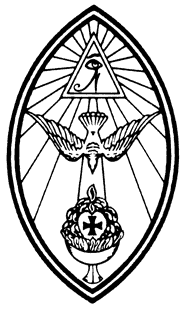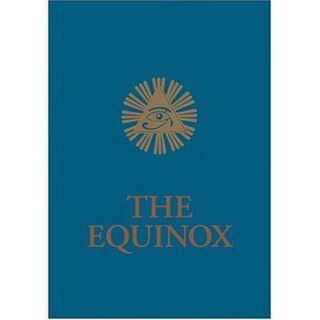
Aleister Crowley was an English occultist, philosopher, ceremonial magician, poet, painter, novelist, and mountaineer. He founded the religion of Thelema, identifying himself as the prophet entrusted with guiding humanity into the Æon of Horus in the early 20th century. A prolific writer, he published widely over the course of his life.

Thelema is a Western esoteric and occult social or spiritual philosophy and new religious movement founded in the early 1900s by Aleister Crowley (1875–1947), an English writer, mystic, occultist, and ceremonial magician. The word thelema is the English transliteration of the Koine Greek noun θέλημα, "will", from the verb θέλω : "to will, wish, want or purpose."

Ordo Templi Orientis is an occult initiatory organization founded at the beginning of the 20th century. The origins of the O.T.O. can be traced back to the German-speaking occultists Carl Kellner, Theodor Reuss, Heinrich Klein and Franz Hartmann. In its first incarnation the O.T.O. was intended to be modelled after and associated with European Freemasonry and as such in its early years only Freemasons could seek admittance. Founder and first head of the Order Carl Kellner desired to create an Academia Masonica wherein various rites of high-degree Freemasonry could be conferred within German-speaking countries. During the course of his esoteric studies across the globe and from many traditions, Kellner believed that he had discovered a "key" which offered a clear explanation of all the complex symbolism of Freemasonry and of nature itself. Kellner intended for the O.T.O. to preserve and confer this "key". Arguably of less interest to Kellner but of importance to co-founder Reuss the O.T.O. was also intended to be a revival of Adam Weishaupt's Bavarian Order of Illuminati.

Ceremonial magic encompasses a wide variety of rituals of magic. The works included are characterized by ceremony and numerous requisite accessories to aid the practitioner. It can be seen as an extension of ritual magic, and in most cases synonymous with it. Popularized by the Hermetic Order of the Golden Dawn, it draws on such schools of philosophical and occult thought as Hermetic Qabalah, Enochian magic, Thelema, and the magic of various grimoires. Ceremonial magic is part of Hermeticism and Western esotericism.
The Babalon Working was a series of magic ceremonies or rituals performed from January to March 1946 by author, pioneer rocket-fuel scientist and occultist Jack Parsons and Scientology founder L. Ron Hubbard. This ritual was essentially designed to manifest an individual incarnation of the archetypal divine feminine called Babalon. The project was based on the ideas of Aleister Crowley, and his description of a similar project in his 1917 novel Moonchild.
Ecclesia Gnostica Catholica (E.G.C.), or the Gnostic Catholic Church, is a Gnostic church organization. It is the ecclesiastical arm of the Ordo Templi Orientis (O.T.O.), an international fraternal initiatory organization devoted to promulgating the Law of Thelema.
Aleister Crowley wrote The Gnostic Mass — technically called Liber XV or "Book 15" — in 1913 while travelling in Moscow, Russia. The structure is similar to the Mass of the Eastern Orthodox Church and Roman Catholic Church, communicating the principles of Crowley's Thelema. It is the central rite of Ordo Templi Orientis and its ecclesiastical arm, Ecclesia Gnostica Catholica.

A lamen is a magical pendant or breastplate worn around the neck so that it hangs upon the breast over the heart. Its uses vary but, most commonly, the term refers to a symbol of authority and a focus of magical energies. Aleister Crowley described the lamen as "a sort of coat of arms. It expresses the character and powers of the wearer." Crowley and DuQuette have proposed that the magical lamen might be a modern adaptation of the priestly breastplate of the ancient Hebrews.
The Cake of Light is the eucharistic host found within Thelema, the religion founded by British author and occultist Aleister Crowley in 1904 and some neo-Gnostic religions. A common "cake of light" contains kamut flour, honey, a few drops of Abramelin oil, olive oil, beeswing, ash, and sometimes particular bodily fluids such as semen, menstrual blood, vaginal fluids, or a mix therein, and is usually cooked in the shape of a small, flat wafer. It appears by name in two important Thelemic rituals: the Gnostic Mass and the Mass of the Phoenix.

Babalon is a goddess found in the occult system of Thelema, which was established in 1904 with the writing of The Book of the Law by English author and occultist Aleister Crowley. The spelling of the name as "Babalon" was revealed to Crowley in The Vision and the Voice. Her name and imagery feature prominently in Crowley's "Liber Cheth vel Vallum Abiegni".
Within Thelema, the Great Work is generally defined as those spiritual practices leading to the accomplishment of the True Will of one's Self in mystical union with the All. Its founder, author and occultist Aleister Crowley, based this path of mystical attainment or enlightenment on his studies in Hermetic alchemy and the Hermetic Qabalah, particularly as they were expounded by Eliphas Levi in the 19th century and later by various members in the Hermetic Order of the Golden Dawn, an occult society of which Crowley had been a member.

Magick, Liber ABA, Book 4 is widely considered to be the magnum opus of 20th-century occultist Aleister Crowley, the founder of Thelema. It is a lengthy treatise on magick, his system of Western occult practice, synthesised from many sources, including Eastern Yoga, Hermeticism, medieval grimoires, contemporary magical theories from writers like Eliphas Levi and Helena Blavatsky, and his own original contributions. It consists of four parts: Mysticism, Magick, Magick in Theory and Practice, and ΘΕΛΗΜΑ—the Law. It also includes numerous appendices presenting many rituals and explicatory papers.

The Book of Lies is a book written by English occultist and teacher Aleister Crowley and first published in 1912 or 1913. As Crowley describes it: "This book deals with many matters on all planes of the very highest importance. It is an official publication for Babes of the Abyss, but is recommended even to beginners as highly suggestive."

In ceremonial magic, a magical formula or a word of power is a word that is believed to have specific supernatural effects. They are words whose meaning illustrates principles and degrees of understanding that are often difficult to relay using other forms of speech or writing. It is a concise means to communicate very abstract information through the medium of a word or phrase.
In ceremonial magic, banishing refers to one or more rituals intended to remove non-physical influences ranging from spirits to negative influences. Although banishing rituals are often used as components of more complex ceremonies, they can also be performed by themselves. Banishing can be viewed as one of several techniques of magic, closely related to ritual purification and a typical prerequisite for consecration and invocation.

The Blue Equinox, officially known as The Equinox: Volume III, Number I, is a book written by the English occultist Aleister Crowley, the founder of Thelema. First published in 1919, it details the principles and aims of the secret society O.T.O. and its ally the A∴A∴, both of which were under Crowley's control at the time. It includes such topics as The Law of Liberty, The Gnostic Mass, and Crowley's "Hymn to Pan".
Eroto-comatose lucidity is a technique of sex magic known best by its formulation by English author and occultist Aleister Crowley in 1912, but which has several variations and is used in a number of ways by different spiritual communities. A common form of the ritual uses repeated sexual stimulation to place the individual in a state between full sleep and full wakefulness as well as exhaustion, allowing the practitioner to commune with their god.
"The Sect of the Phoenix" is a short story by Argentine writer Jorge Luis Borges, first published in Sur in 1952. It was included in the 1956 edition of Ficciones, part two (Artifices). The title has also been translated as "The Cult of the Phoenix."
Therion (thēríon) is a deity found in the mystical system of Thelema, which was established in 1904 with Aleister Crowley's writing of The Book of the Law. Therion's female counterpart is Babalon, another Thelemic deity. Therion, as a Thelemic personage, evolved from that of "The Beast" from the Book of Revelation, whom Crowley identified himself with since childhood, because his mother called him that name. Indeed, throughout his life he occasionally referred to himself as “Master Therion” or sometimes “The Beast 666”. He wrote:
Before I touched my teens, I was already aware that I was THE BEAST whose number is 666. I did not understand in the least what that implied; it was a passionately ecstatic sense of identity.










